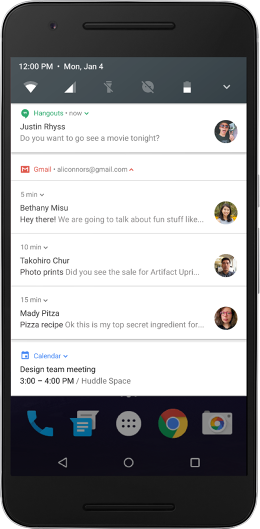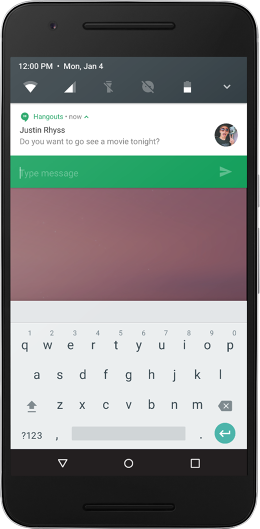Notifications suck. They're constantly disrupting us with pointless, ill-timed updates we don't need. True, sometimes they give us pleasure—like when they alert us of messages from real people. And sometimes they save our bacon, by reminding us when a deadline is about to slip by. But for the most part, notifications are broken—a direct pipeline of spam flowing from a million app developers right to the top of our smartphone screens.
During a frank session at the 2016 I/O developer conference, Google researchers Julie Aranda, Noor Ali-Hasan, and Safia Baig openly admitted that it was time for notifications to get a major design overhaul. "We need to start a movement to fix notifications," said Aranda, a senior UX researcher within Google.
As part of their research into the problem, Aranda and her colleagues conducted a UX study of 18 New Yorkers, to see how they interacted with notifications on their smartphones, what they hated about them, and what could be done to fix notifications in future versions of Android.

According to Google's research, the major problem with notifications is that developers and users want different things from them. Users primarily want a few things from notifications. First and foremost, they want to get notifications from people. "Notifications from other people make you feel your existence is important," said one of their research subjects, Rachael. And some people are more important than others, which is why notifications from people like your spouse, your mom, or your best friend are more important than a direct message on Twitter, or a group text from the people in your bowling league. In addition, users want notifications that help them stay on top of their life—a reminder of an upcoming deadline or doctor's appointment, for example.
But developers want something different from notifications. First and foremost, they design their notifications to fulfill whatever contract it is that they feel that they have with their users. So if you've designed an exercise app, you might alert someone when they haven't worked out that day; if you are a game developer, you might tell them when someone beat their high score. Yet according to Google, research suggests that the majority of users actively resent such notifications. And that's doubly true for the other kind of notifications developers want to send—notifications that essentially serve no function except to remind users that their app is installed on a user's phone. Google calls these "Crying Wolf" notifications and says they're the absolute nadir of notification design.

This disconnect between what users and developers want is so severe that users go through extreme measures to get away from notifications. Google said that it's seeing more and more users foregoing installing potentially notification-spamming apps on their phones when they can access the same service through a website—where notifications will never be an annoyance. And this actually explains a lot about Google's interest in fixing the notifications problem, because people who aren't downloading Android apps aren't locked into the platform, and aren't spending money on Google Play.
So what's Google doing to fix notifications? In the forthcoming Android N update, the company is introducing a feature that highlights notifications from anyone on a user's VIP list in a different color and places them at the top of the stack. They've also added inline replies to notifications to make them more quickly actionable. And while Google says it's only just started to ideate ways to improve notifications in Android O and beyond, comments made by Aranda, Ali-Hasan, and Baig indicated that there could be a number of changes to notifications made in the near future, including the ability of users to prioritize notifications, assign LED light patterns to important notifications, and even apply machine learning to keep unwanted notifications from constantly reappearing on a user's smartphone.
Such changes to Android's notification system are at least a year away.
In the meantime, Google is highlighting what it calls the principles of good notifications for developers: A well-designed notification will be relevant to their users, they'll be actionable, they'll be worth the time of reading, and they'll have a legitimate reason to interrupt users.
One surprising thing revealed by Google's research? Aranda says they found that people tended to open games, social networks, and news apps so often that notifications actually tended to actually drive users away from the apps, not vice versa. So maybe the most important principle of good notifications is this: Your app probably doesn't need them at all.
All Images: via Google